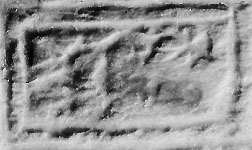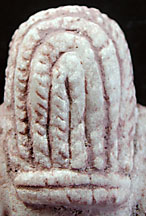 The
oldest seems to be the standing Inanna with the long inscription on her skirt
(G-Sum 4). She wears her hair in long, thin strips that fall from a center part.
It likely dates from c. 2600-2400 B.C.
The
oldest seems to be the standing Inanna with the long inscription on her skirt
(G-Sum 4). She wears her hair in long, thin strips that fall from a center part.
It likely dates from c. 2600-2400 B.C.
The collection has three statues of Sumerian women covering an approximate period of 600 years, and presumably from a single site. Each shows a different, yet historically recorded, manner of arranging their hair.
 The
oldest seems to be the standing Inanna with the long inscription on her skirt
(G-Sum 4). She wears her hair in long, thin strips that fall from a center part.
It likely dates from c. 2600-2400 B.C.
The
oldest seems to be the standing Inanna with the long inscription on her skirt
(G-Sum 4). She wears her hair in long, thin strips that fall from a center part.
It likely dates from c. 2600-2400 B.C.
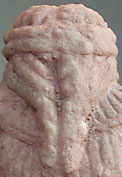 The
next is the seated goddess with her hair done in double braids (G-Sum 3), the
most common Sumerian style for women. She also has a hair band to hold the hair
in place, as does the god in G-Sum 1 (and on Arabic head scarves today). This
statue likely dates from c. 2300-2000 B.C.
The
next is the seated goddess with her hair done in double braids (G-Sum 3), the
most common Sumerian style for women. She also has a hair band to hold the hair
in place, as does the god in G-Sum 1 (and on Arabic head scarves today). This
statue likely dates from c. 2300-2000 B.C.
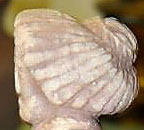 The
last is the large statue of a goddess or worshipper with the hair braided and
wrapped in a bun on the back (G-Sum 2). The well known bronze head of the Akkadian
king Sargon has this hair style as well, so men also used the technique. This
statue most likely is early Old Babylonian and dates to c. 1800 B.C.
The
last is the large statue of a goddess or worshipper with the hair braided and
wrapped in a bun on the back (G-Sum 2). The well known bronze head of the Akkadian
king Sargon has this hair style as well, so men also used the technique. This
statue most likely is early Old Babylonian and dates to c. 1800 B.C.
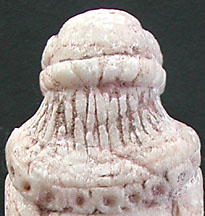
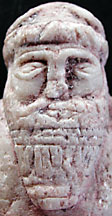 For
comparison we can look at the hair on the only male statue (G-Sum 1) which hangs
in locks much as the goddess in G-Sum 4, but with a retaining band as G-Sum
3. The hair locks are as well defined as those of the goddess G-Sum4, but his
hair is not twisted as is that of the goddess. The drillings indicating the
curled ends of his hair show clearly, but this is the only place on the statue
that drilling was used. He seems to have an early hair style free from the complicated
fashions of later periods. Looking at the beard of the statue it has the carefully
manicured and curled look of later Babylonian and Assyrian beards, rooughly
dating this statue at the boundary between late Sumerian and Old Babylonian.
For
comparison we can look at the hair on the only male statue (G-Sum 1) which hangs
in locks much as the goddess in G-Sum 4, but with a retaining band as G-Sum
3. The hair locks are as well defined as those of the goddess G-Sum4, but his
hair is not twisted as is that of the goddess. The drillings indicating the
curled ends of his hair show clearly, but this is the only place on the statue
that drilling was used. He seems to have an early hair style free from the complicated
fashions of later periods. Looking at the beard of the statue it has the carefully
manicured and curled look of later Babylonian and Assyrian beards, rooughly
dating this statue at the boundary between late Sumerian and Old Babylonian.
Several of the Egyptian pieces show standard archaeological dig or collector’s labels lettered in black ink on white paint spots. The labels seem to reference 1936–1940 dates, which would match well with Golf’s known dates for working in the region. If we can indentify the source of the labeling we could more reliably locate many of these items.
 Labels from the three pieces of G-Egy 11 dating to 1936.
Labels from the three pieces of G-Egy 11 dating to 1936.
![]() Label
from G-Egy 34 dating to 1940.
Label
from G-Egy 34 dating to 1940.
Almost all the Sumerian seals have inscriptions, but most of the statues do as well. Most have only a brief dedicatory panel, but one has a 28 register inscription that tells a considerable story of its probably religious dedication.
Inscription from the skirt of G-Sum 4.
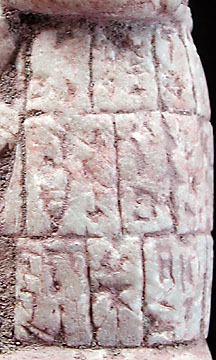
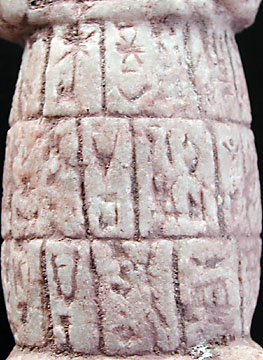
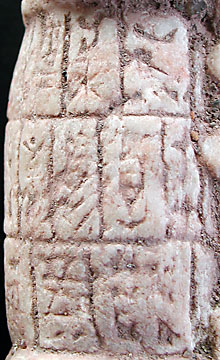
Dedication inscription from the back panel of the G-Sum 1 god.
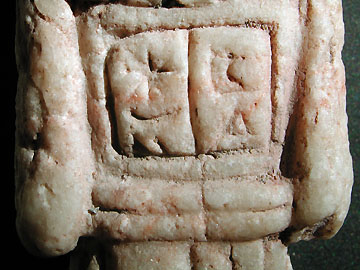
Dedication inscription from the back panel of the G-Sum 2 goddess statue.
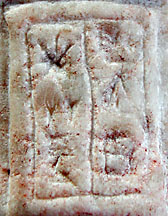
Dedication inscription from the G-Sum 6 Votive Boat, badly worn and difficult to decipher. At first glance it seems almost pictographic.
